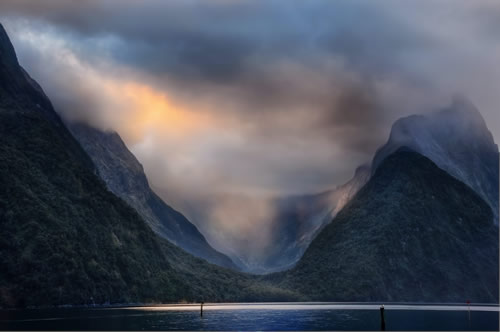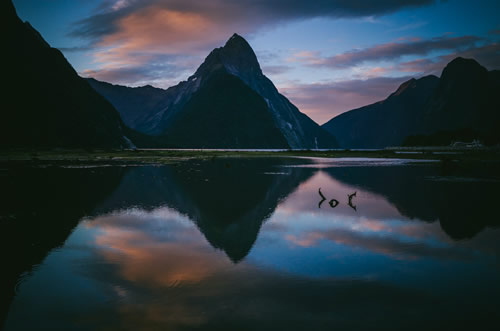- Home ›
- NZ Regions ›
- Southland Region ›
- Milford Sound
Milford Sound New Zealand: A Natural Wonder of the World
New Zealand is renowned for its breathtaking landscapes, lush greenery, and captivating natural wonders. Among the countless jewels in its crown, Milford Sound stands out as an iconic destination that leaves visitors in awe of its sheer grandeur.

Photo by Peter Hammer
Located on the southwest coast of New Zealand's South Island, Milford Sound (Piopiotahi) is often described as the "Eighth Wonder of the World". Explore the beauty, history, and attractions of this remarkable destination that continues to captivate travellers from around the globe.
Milford Sound Geography and Formation
Milford Sound is not a sound in the conventional sense, but rather a fjord—a long, narrow inlet with steep cliffs carved by glaciers in the Fiordland National Park, South Island, New Zealand. This geographical distinction is significant, as it contributes to the dramatic, almost otherworldly scenery that awaits visitors.
The fjord runs 15 kilometres inland, surrounded by towering, rugged mountains and dense rainforests, culminating at the stunning Mitre Peak, which rises 1,692 meters (5,551 feet) above sea level.
How Was Milford Sound Formed
The fjord's origin can be traced back to the last ice age, approximately 20,000 years ago, when massive glaciers carved out the deep valleys that would later become Milford Sound. As the ice receded, the sea flooded these valleys, creating the magnificent waterway we see today.
The combination of ancient glacial forces and constant, lush rainforest growth has resulted in a landscape of unparalleled beauty.
Milford Road Highway SH94 - Te Anau to Milford Sound

Photo by Jasper Van der Meij
Piopiotahi Maori Connection
Before European exploration and colonisation, Milford Sound was inhabited by the Maori people, New Zealand's indigenous population. The Maori referred to the area as "Piopiotahi," named after a now-extinct bird that once inhabited the region. The Maori have rich mythological and cultural connections to the land, with stories and legends that add depth and meaning to the landscape.
One such story involves the creation of the fiords. According to Maori legend, the god Tu-te-raki-whanoa carved out the landscape with his toki (adze), shaping the fiords and valleys. This legend offers a spiritual connection to the land that is still present in the local Maori culture today.
Milford Sound's Maori heritage can be experienced by visitors through guided tours and cultural performances, providing a deeper understanding of the region's significance.
Milford Sound Flora and Fauna
Milford Sound is not only a visual marvel but also a sanctuary for diverse plant and animal life. The lush rainforests that blanket the cliffs and mountains are teeming with life. The temperate climate and heavy rainfall create ideal conditions for a wide variety of plant species, from ancient mosses to towering ferns and beech trees. Other trees to spot in the forest are Miro, Totara New Zealand Rimu.
Among the native bird species, the Kea (a large alpine parrot) and the Takahe (a flightless bird) are notable inhabitants. Little Blue penguin is relatively common but the Fiordland Crested Penguin are extremely rare and endangered, as are the Blue Duck. Also look for Kakapo, Mohua, (Yellowhead), Shags (cormorants), and Sooty Shearwaters.
In the waters of Milford Sound, you can spot an array of marine life. Bottlenose dolphins, Dusky dolphins, and New Zealand fur seals frequently visit the fjord, and for those who venture beneath the surface, the world of Milford Sound opens up further. Divers and snorkellers are rewarded with glimpses of colourful sponges, anemones, black coral, and a variety of fish species, making this a fantastic destination for underwater enthusiasts as well.
Milford Sound Waterfalls
One of the most enchanting features of Milford Sound is its waterfalls. After rainfall, the fjord comes alive with hundreds of temporary waterfalls cascading down the cliffs. The most famous of these is Stirling Falls, which plummets 151 meters (495 feet) from a sheer rock face. These ephemeral waterfalls, combined with the lush vegetation, create an atmosphere of pure magic, transporting visitors into a world of serene natural beauty.
Native New Zealand birds and animals
Cruise and Kayaking Adventures on Milford Sound
One of the best ways to explore the grandeur of Milford Sound is by taking a boat tour or a kayak expedition. Cruise operators offer various options, from short day trips to overnight adventures, allowing visitors to appreciate the beauty of the fjord in different ways.
A boat tour will take you deep into the heart of Milford Sound, giving you the opportunity to sail past towering cliffs, experience the thrill of Stirling Falls, and observe birds and wildlife in their natural habitat. The water's mirror-like surface on calm days reflects the surrounding peaks, creating postcard-worthy scenes at every turn.
For those seeking a more intimate experience, a Milford Sound kayak tour is an excellent choice. Kayaking along the water, you can get up close and personal with the fjord's features, such as waterfalls, sheer cliffs, and wildlife. While it requires a bit more effort to kayak Milford Sound, the serenity and the chance to explore secluded corners of the fjord are worth every stroke of the paddle.
The Milford Track
Beyond the fjord itself, the Milford Track is a renowned hiking trail that takes you on a four-day journey through the heart of Fiordland National Park. Often referred to as "the finest walk in the world," the Milford Track offers an unparalleled opportunity to immerse yourself in the surrounding wilderness. The trail covers 53.5 kilometers (33.2 miles) of diverse landscapes, from dense forests to pristine lakes and mountainous terrains.
Trekkers on the Milford Track can explore Sutherland Falls, one of New Zealand's highest waterfalls, and pass through Mackinnon Pass, which offers breathtaking panoramic views of the surrounding landscape.
Hut accommodations along the trail provide a comfortable and environmentally friendly way to experience this awe-inspiring journey.
Getting there: SH94 - Te Anau to Milford Sound Route
Milford Sound New Zealand Weather and Best Time to Visit
Milford Sound experiences a high level of rainfall throughout the year, making it one of the wettest places in New Zealand. While this might sound like a deterrent, it's precisely this heavy rainfall that creates the enchanting waterfalls and sustains the lush rainforest. Therefore, visitors should be prepared for the possibility of rain at any time of the year.
The best time to visit Milford Sound largely depends on your preferences. The summer months of December through February offer the warmest weather and longer daylight hours, making it the peak tourist season. However, this is also the wettest time of the year, so be prepared for rain.
If you prefer fewer crowds and don't mind cooler temperatures, the shoulder seasons of spring (September to November) and autumn (March to May) can be excellent times to visit. The landscape is equally stunning, and you'll have a more tranquil experience.
Milford Road may be closed at times during winter, May to November, depending on weather and road conditions
Related Information - SH94 Route to Milford Sound - Milford Track
Fiordland National Park - Southland - Te Anau - National Parks - Great Walks
How to Get to Milford Sound New Zealand Map of Location
This map shows where Milford Sound is located and if you zoom out you will see the route to get there. Zoom in to view local places and more detail.
Milford Road Highway SH94 - Te Anau to Milford Sound Route
Experience and Preserve
Milford Sound, New Zealand, is a place of unmatched natural beauty and serenity. Its majestic fjords, rich history, and diverse wildlife make it a destination that continues to captivate the hearts of travellers worldwide. Whether you choose to explore the fjord by boat, kayak, or embark on a multi-day hike, Milford Sound will leave you with indelible memories. It's a testament to the sheer power of nature and the enduring allure of the untouched wilderness, reminding us of the importance of preserving such extraordinary places for generations to come.